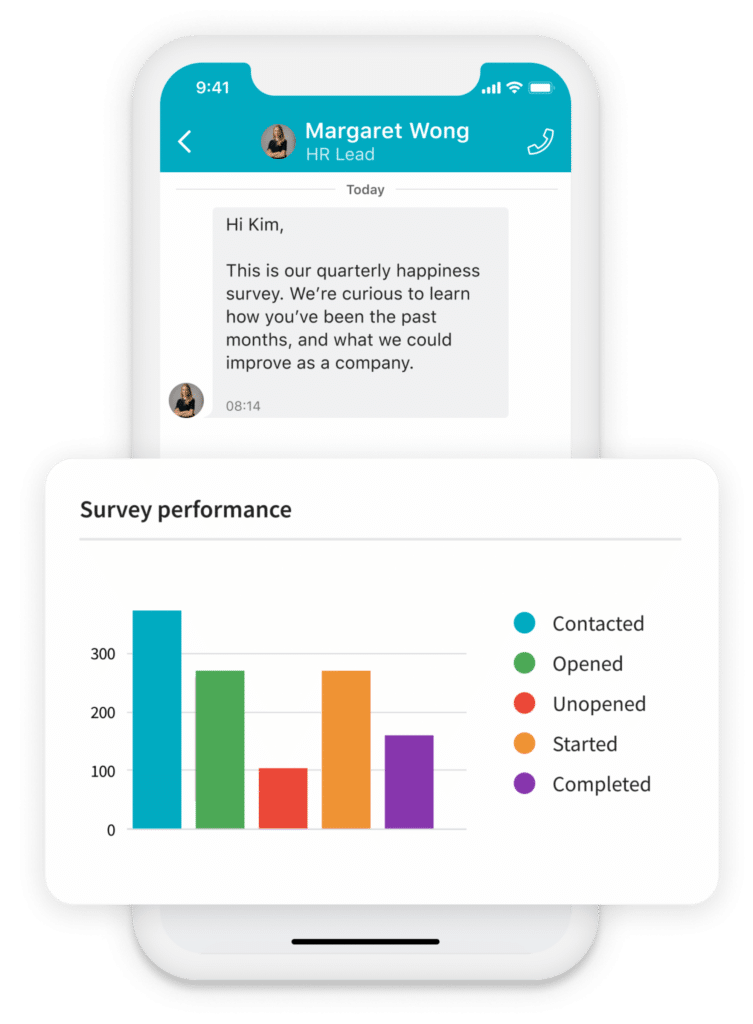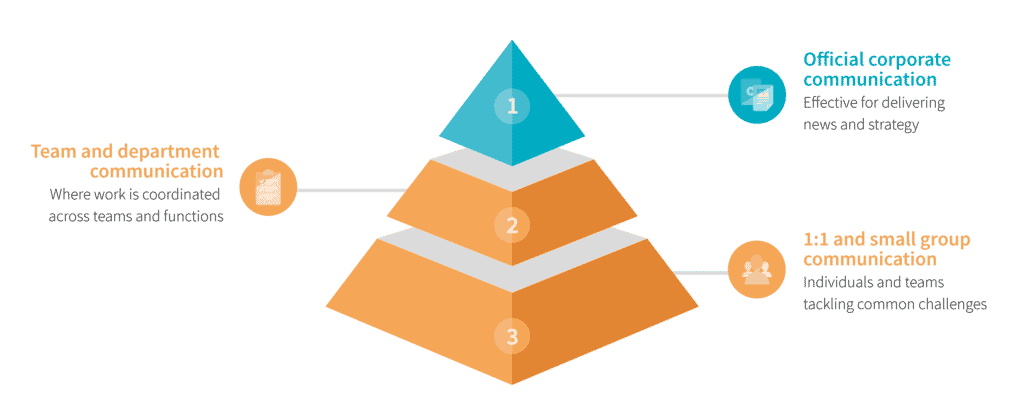Table of contents
- What Is Enterprise Collaboration Software?
- 7 Reasons Why Enterprise Collaboration Software Matters
- Collaboration Challenges Frontline Workers Face
- Industries that Benefit from Better Collaboration
- Why You Should Invest in Enterprise Collaboration Software
- Enterprise Collaboration In Practice
- Enterprise Collaboration: What it Takes to Succeed
- Frequently Asked Questions
After the uncertainty of the pandemic, one thing has become clear: remote work is here to stay. More companies have embraced remote work as the “new normal,” and there’s been increasing demand for enterprise collaboration software. In fact, 39% of executives believe that an enterprise collaboration tool is the most important factor in making remote work sustainable.
Want to know how to choose the best team collaboration software? Download our eBook.
Continue reading to get an in-depth look at what enterprise collaboration software can offer big companies, particularly ones that employ frontline workers.
What Is Enterprise Collaboration Software?

At its most basic, enterprise collaboration software encompasses any platform that enables enterprise-level teams to collaborate. It answers the question: how can a large organization communicate in a way that increases productivity and employee engagement?
Enterprise collaboration software is a broad term that can include tools like document collaboration programs, email, and instant messaging.
With it, employees can:
- Store, share, and access information
- Keep track of tasks, both individually and as a team
- See how big-picture goals relate to day-to-day tasks
Most importantly, enterprise collaboration software is about knowledge sharing and keeping track of tasks in a way that makes collaboration easier and more streamlined.
When a company chooses specific enterprise collaboration software, employees have all the tools they need in one place. Teams aren’t left to piece together different apps that serve different purposes. Having one enterprise collaboration platform allows employees to collaborate more efficiently.
Enterprise collaboration software platforms are usually mobile-friendly, allowing remote employees to connect with colleagues and access documents on their mobile devices.
Enterprise Collaboration System vs. Software
The terms “enterprise collaboration system” and “enterprise collaboration software” are often used interchangeably.
When you’re talking about an enterprise collaboration system, you expect it to make use of the software. On an enterprise level, collaborating without software simply isn’t practical. Enterprise collaboration software is what brings employees together across different teams and locations, allowing everyone to easily collaborate within a unified digital workplace.
But here’s why it can be useful to distinguish the system from the software:
If you think of systems as existing independently from software, you can start with the system that suits a company’s unique needs. Factors like the number of employees, expected outcomes, and workflows all play a role in what would be the ideal system for that company.
A company that uses software that isn’t suited to its ideal system is not going to maximize its collaborative potential.
On the other hand, a company that starts by analyzing what its enterprise collaboration strategy looks like currently – and how it could improve – is in a more informed position to choose the right software.
That being said, let’s take a look at how enterprise collaboration software systems can benefit all large companies.
7 Reasons Why Enterprise Collaboration Software Matters
It’s no surprise that in May of 2020, just after the pandemic hit, there was a 176% increase in the number of collaboration apps installed on enterprise devices. As more people transitioned to working from home, companies needed to make sure teams could collaborate remotely.
While using enterprise collaboration platforms may be considered “normal” now, it’s helpful to examine why it matters in the first place. Doing so can highlight the essential functions and outcomes any enterprise collaboration software should provide. If it doesn’t, it might be a good time to seek out alternatives.
Here are some key benefits of using enterprise collaboration platforms:
1. Increased Productivity
Enterprise collaboration software is designed to give employees more access to information and provide the opportunity to ask for assistance or feedback. With open, two-way communication channels, employees have more resources at their disposal to get their work done faster.
Forrester found that companies can drive 10% productivity improvements with collaboration platforms.
On an enterprise level, every minute that an employee saves makes a huge difference to the company’s bottom line.
2. Better Feedback
Gathering better workforce feedback can boost employee engagement, build trust in leadership, and improve workplace culture. When employees have the opportunity to give and receive feedback, they can voice their concerns, needs, and struggles before they become operational bottlenecks.
More opportunities for feedback create more open communication, which in turn leads to happier employees.
A survey found that 85% of employees who had access to collaborative work management software were more likely to identify as being happy in the workplace.

Feedback can take many forms, including employee surveys and communication channels where workers can contact their managers in real-time. Beekeeper, a platform designed specifically for frontline industries, has both of those collaboration features. They allow frontline workers to communicate openly with both management and their peers about issues like workplace safety and job satisfaction.
Pro Tip: Gather better workforce feedback to improve workplace culture as part of your enterprise collaboration strategy and stay attuned to your employees’ needs.
3. Faster Problem Solving
There are two main reasons why roadblocks happen in the workplace:
- Lack of information
- Poor communication
Those roadblocks can cause misunderstandings and delays that cost time and money to fix.
But it’s rare that people are at fault in these two scenarios. Rather, it’s the enterprise collaboration platforms they’re given that often let them down. In a recent study, 86% of employees believed that lack of collaboration and ineffective communication was the reason for workplace failures.
Digitizing workflows and approval processes can go a long way toward empowering employees to solve problems on their own. And if they can’t do it alone, they know where they can find answers.
4. Bottom-Up Communication
In a company where information flows strictly from top to bottom, from leadership to entry-level employees, opportunities for insightful and productive collaboration are often lost.
Bottom-up leadership breaks up a rigid corporate hierarchy and encourages communication to flow both ways. When you flip the traditional, top-down communication model on its head, employees are more likely to work together, building morale and a sense of community.

Enterprise-level companies need collaboration software designed to connect large groups of employees that may be spread out across different locations. Lack of management software that supports bottom-up leadership can create organizational problems (or exacerbate existing ones) like high turnover, the spread of misinformation, and overall employee dissatisfaction.
5. Messaging and Meetings
Enterprise-level organizations have a lot of different types of communication to keep track of:
- 1:1 conversations
- Team collaboration
- Newsletters and campaigns
- Company and team-wide announcements
- Critical alerts
Keeping these organized is a crucial part of an efficient enterprise collaboration strategy. For frontline or distributed workforces, enterprise collaboration tools that offer mobile, real-time messaging allow workers to stay connected no matter where they’re located.
Post-pandemic, we’re seeing more organizations embrace mobile collaboration tools. In fact, Gartner found that real-time mobile messaging tools saw an increase of 7% from 2019-2021.
6. Project Management
According to PMI, project management is “the use of specific knowledge, skills, tools, and techniques to deliver something of value to people.” Good project management tools allow organizations to carry out:
- Task management
- Long and short-term project planning
- Documentation
- Evaluation/tracking progress
Project management tools aren’t just for project managers. Choosing enterprise collaboration tools with strong project management capabilities allows teams of different sizes and goals to have more:
- Transparent communication
- Accountability
- Awareness of a project’s timeline
7. Managing Processes
Perhaps the best way to understand process management is to look at what happens when processes are broken:
- Projects keep getting delayed
- Work has to be re-done because of mistakes
- More money invested isn’t yielding results
- Cross-departmental conflict
- Frustration expressed by employees
Getting to the root cause of broken processes can mean asking:
- Are goals, roles, and responsibilities clear?
- Do employees have sufficient information?
- Do organizational structures support processes?
- Are results adequately measured and analyzed?
With enterprise collaboration platforms, organizations can more accurately diagnose why processes might not be working and come up with better solutions. The right tools can help define roles, supply employees with the right information, and measure progress.
Collaboration Challenges Frontline Workers Face

The majority of innovative enterprise collaboration tools on the market were created primarily for office workers.
But in reality, it’s the frontline workers who often need this collaboration software the most. There are 2.7 billion workers in the world that don’t work at a desk. Most are employed in frontline positions that involve physical labor, moving between locations, and customer-facing roles.
The problem with those non-desk workers adopting traditional communication tools is that those programs are designed to resemble office spaces. The enterprise collaboration strategy in an office should look completely different from the one frontline workers use.
While it’s possible for a frontline team to use these tools effectively, it’s not ideal. Frontline teams have different needs, which are not met by platforms designed for desk-bound workers.
Psst! Want to know what it takes to keep frontline workers engaged? Take a look at our guide: Employee Engagement: How to Keep Frontline Employees Motivated at Work
Finding mobile-first software for online collaboration is just one collaboration challenge that non-desk workers face.
Here are a few more:
Mobile Accessibility
If deskless workers can’t connect and collaborate via mobile, they are essentially detached from the company they work for. Not only does this signal to them that the company isn’t invested in helping them succeed, but it also isolates these workers and creates more opportunities for misunderstandings around goals, policies, and proper procedures.
At worst, employees can feel invisible. Take Elizabeth Peachy, a home health aide, who says that she isn’t given any resources other than a website to do her job. Yet she is expected to navigate the challenges of caring for high-risk patients during COVID-19.
Collaboration software that’s accessible via mobile might not solve Elizabeth’s lack of benefits or PPE. But at least it would open up a dialogue between her and the company she works for so that they could collaborate together to find solutions for better care.
Language Barriers
Most companies that employ deskless employees have a diverse, multilingual workforce. When a company distributes content like policy updates, safety information and surveys, employees who have to translate that content on their own are less likely to engage with it. Communication between colleagues who speak different languages becomes more difficult if both parties constantly have to reach for Google Translate.
To solve the language barrier that prevents seamless collaboration in a multilingual environment, look for tools embedded with inline translation features. That way, employees can read and respond to content without having to take an extra step.
Lack of Connection
Before collaboration can even become normalized in an organization, employees have to feel that it serves a purpose in the first place. Unfortunately, that’s not always true for deskless workers.
A 2019 survey of senior managers and frontline employees found that 74% of deskless workers thought there were barriers to communication where they work. They felt that teams weren’t working together and there was no way to engage with leadership and share ideas.
True collaboration can’t happen when employees believe that there is little point in knowledge sharing. Companies first need to build trust with their employees by adopting software and tools that encourage open communication.
Industries that Benefit from Better Collaboration
You’d be hard-pressed to find an industry or company that wouldn’t benefit from increased collaboration. But several industries stand out for needing increased collaboration at this point in time.
Manufacturing
One of the key manufacturing industry trends includes the digital enablement of frontline workers to improve employee health and safety. Manufacturing companies would benefit from enterprise collaboration tools that engage workers to help build safer environments for all employees.
Enterprise collaboration tools help connect employees on the manufacturing floor, who are closest to the action, as well as managers that can use their feedback to make higher-level decisions. By increasing real-time communication during the production process, manufacturing companies can boost efficiency and promote transparency with management.
Food Service and Delivery
In 2020, the pandemic transformed the food industry with an increased emphasis on third-party delivery, online grocery shopping, food delivery subscriptions, and delivery tracking.
As the food industry relies more on technology to execute complex delivery models and demands, enterprise collaboration tools can help workers stay connected. Team communication in the food industry is becoming more important than ever as customers have come to expect fast and efficient delivery.
Utilities
During the 2020 pandemic, more and more utility companies had to adopt new tools to literally keep the lights on. While the digital transformation in utilities is by no means complete, companies are starting to become more open to streamlining operations through a more collaborative process.
Enterprise collaboration tools can help protect utility workers by allowing workers to offer feedback about worker safety. Managers can, in turn, use that feedback to create better safety guidelines and distribute them to workers.
Why You Should Invest in Enterprise Collaboration Software
Earlier in this article, we talked about the difference between an enterprise collaboration system and software. Many large companies already have a system in place that may have been developed over years or even decades. Updating these systems and switching to digital solutions can be daunting.
Here’s why enterprise-level organizations might want to consider adopting enterprise collaboration software that takes care of all their needs:
Centralized Internal Communication
Enterprise collaboration software gives every worker access to a single platform that serves as the central hub for all communication. They can store and reference documentation, contact managers and colleagues, and check for important updates.
By centralizing communication in this way, employees don’t have to waste time jumping between different apps and tools. They can instead spend more time on productive collaboration, like giving feedback to managers about improving the workplace.
Transparent Objectives
Without software to centralize internal communication, teams can start to operate in silos with little opportunity for cross-team collaboration. That can lead to:
- Redundancies in operations and delays in fixing them
- An uneven distribution of resources/attention
- Miscommunication that impacts customer satisfaction
- Workers who feel disengaged from company objectives
Each one of these consequences impacts a company’s revenue. For example, a report found that disengaged employees cost U.S. companies $550 billion each year.
Enterprise collaboration software helps all employees get a better idea of how their work relates to the company’s objectives. By promoting transparent communication, a company can empower its employees to allocate their efforts to the most urgent and important tasks.
Lean Operations
The basic principle behind lean operations is doing more with less. Its purpose is to reduce wasted energy, resources and time by continuously refining operations. On an enterprise level, this requires input from employees across all teams.
Factory managers, for example, don’t have the same perspective as workers on the floor, who may have specific insight into how to streamline operations. When those factory floor workers can connect to managers in real-time, they can help achieve lean operations at a faster rate.
Reducing waste by focusing on lean operations can make a significant impact on a company’s bottom line. Take Holcim, a global manufacturer of building materials, who connected their 1,500 distributed employees with a digital solution for lean communication.
This allowed them to eliminate the cost of printing their newsletter and save $50,000.
Enterprise Collaboration In Practice
Still not convinced that investing in enterprise collaboration software is worth it? Here are some real-world examples of how companies have used software to simplify their operations, reduce overhead, and drive innovation.
AGCO Corp
The agricultural machinery company AGCO had to revamp its internal communications after years of growth. They had a global workforce distributed among multiple brands, each with its own system of operations.
They could have grown each of those systems separately or centralized communication on one enterprise collaboration platform. By choosing the latter, they encouraged collaboration between brands to develop and innovate new products. They were able to unify their brand voice and collectively create solutions that better responded to customer needs.
Centralizing their internal communication simplified AGCO’s operations and reduced unnecessary expenses, like travel for meetings. This ultimately led to a cost reduction of $45,000 per month.
Flagger Force
Flagger Force, a traffic control company, started using Beekeeper to unite their distributed frontline workforce. 78% of their employees adopted the platform, and after continued use, 90% of their employees were actively engaging with it.
Flagger Force’s team managers use Beekeeper’s Chats feature to connect with their team and create topically focused content Streams. These encourage employees to contribute ideas on how to improve workplace operations and safety.
Their content creation system involves all employees, from managers who generate topic ideas to staff who are trained in posting guidelines. Evidence of employee engagement came through, with 33,000 posts logged in 2018.
Mandarin Oriental
As the hospitality industry took a major hit during the pandemic, the Mandarin Oriental Hotel Group had to find a way to keep their employees informed about the latest health and safety procedures.
With the help of Beekeeper, Mandarin Oriental was able to keep their furloughed and active employees informed about the shifting policies regarding the pandemic. Furloughed employees who didn’t have access to their email addresses could still find out information about returning to work. And frontline teams had mobile access to documents that helped them continue to serve guests safely.
Enterprise Collaboration: What it Takes to Succeed
Post-COVID, we’re living in a world that is much more familiar with enterprise collaboration than before. According to Gartner, nearly 80% of workers use collaboration tools for work.
But what makes enterprise collaboration effective?
As we’ve mentioned earlier, choosing the right enterprise collaboration tool is one of the best ways to make collaboration smarter and more efficient. In a nutshell, an enterprise collaboration tool takes care of the how so that employees can focus on the more important whys and hows.
Frequently Asked Questions
What is enterprise collaboration software?
At its most basic, enterprise collaboration software encompasses any enterprise collaboration platform that enables enterprise-level teams to collaborate. It answers the question: how can a large organization communicate in a way that increases productivity and employee engagement?
Why does enterprise collaboration software matter?
- Increased Productivity
- Better Feedback
- Faster Problem Solving
- Bottom-Up Communication
- Messaging and Meetings
- Project Management
- Managing Processes

About the author
Beekeeper
We make frontline lives easier, work safer, and teams more connected so businesses can reach new heights. At Beekeeper, we’re dedicated to making frontline lives easier by connecting workers with the tools, support, and information they need to feel valued, do their best work, and drive the business forward.








